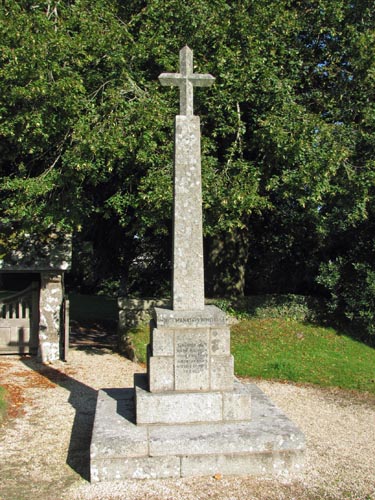| Manaton Memorial Cross |
 Location:
Just inside the lych gate
to Manaton Churchyard. Location:
Just inside the lych gate
to Manaton Churchyard.O/S Grid Ref: SX/74958/81279 Longitude/Latitude (Degrees+/-): -3.76888/50.61777 Map location: Click here to view map. Purpose: The cross serves as the village war memorial. Size: The shaft is 7 feet 2 inches (2.18 metres) tall and measures 14 inches (0.36 metres) square at the base. It is not possible to reach up to measure the head, but it is estimated to be around 2 feet 6 inches (0.76 metres) tall and 2 feet (0.61 metres) across the arms. Information: The head of the cross is unusual in that both the shaft and the arms are chamfered to a point, both along their edges and at their ends. The shaft is set into a large socket stone arrangement, on a plinth of two steps. The socket stone measures 2 feet 10 inches (0.86 metres) high by 3 feet (0.91 metres) wide and 2 feet 6 inches (0.76 metres) deep. The top step of the plinth is 12 inches (0.30 metres) high by 4 feet (1.22 metres) wide and 3 feet 6 inches (1.07 metres) deep. The bottom step is 14 inches (0.36 metres) high by 7 feet (2.13 metres) wide and 6 feet 6 inches 1.98 metres) deep. The cross is dedicated to the local men who lost their lives during both World War I and II. Shown around the top of the four edges of the socket stone are the words: In Grateful Memory of the / Men of Manaton who fell / in the Great War 1914 - 1919 / To the Glory of God. The western face of the socket stone also shows the words: Greater Love Hath no Man Than This That a Man Lay Down his Life for his Friends. The eastern face shows the names of the men who died during the first World War and the southern face shows those who perished during the second World War 1939 - 1945.
The village of Manaton is stretched
out for some distance along the road and is really two villages merged
into one. The upper village is centred around the Church, Village
Hall and Green, At the far end of the churchyard, from the lych gate, stands an ancient waymarker cross, which probably once stood on a track leading to the church, but has now been brought into the churchyard for safekeeping. |